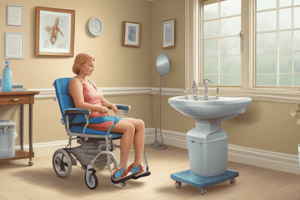Podcast
Questions and Answers
Which medication class is least likely to contribute to urinary incontinence?
Which medication class is least likely to contribute to urinary incontinence?
- Diuretics
- ACE Inhibitors
- Anticholinergics
- Beta-blockers (correct)
A patient reports urine leakage when laughing or sneezing. Which type of urinary incontinence is the patient most likely experiencing?
A patient reports urine leakage when laughing or sneezing. Which type of urinary incontinence is the patient most likely experiencing?
- Reflex Incontinence
- Urge Incontinence
- Overflow Incontinence
- Stress Incontinence (correct)
Which of the following is least likely to be a contributing factor to urinary incontinence?
Which of the following is least likely to be a contributing factor to urinary incontinence?
- Atrophic Vaginitis
- Urinary Retention
- Increased Mobility (correct)
- Fecal Impaction
Which of the following is a recommended treatment for stress incontinence related to relaxed pelvic floor musculature?
Which of the following is a recommended treatment for stress incontinence related to relaxed pelvic floor musculature?
Which of the following is a treatment approach for urge incontinence?
Which of the following is a treatment approach for urge incontinence?
Why is urinary incontinence more prevalent in older women, although it is not considered a natural consequence of aging?
Why is urinary incontinence more prevalent in older women, although it is not considered a natural consequence of aging?
A patient with benign prostatic hyperplasia (BPH) undergoes prostate surgery and subsequently experiences stress incontinence. What is the most likely cause?
A patient with benign prostatic hyperplasia (BPH) undergoes prostate surgery and subsequently experiences stress incontinence. What is the most likely cause?
Besides medication, what lifestyle change is most likely to reduce symptoms of stress incontinence?
Besides medication, what lifestyle change is most likely to reduce symptoms of stress incontinence?
A patient reports a sudden, strong urge to urinate followed by involuntary urine loss before reaching the toilet. Which type of urinary incontinence is the MOST likely diagnosis?
A patient reports a sudden, strong urge to urinate followed by involuntary urine loss before reaching the toilet. Which type of urinary incontinence is the MOST likely diagnosis?
A patient with urinary incontinence voids frequently in small amounts. Which additional symptom would MOST strongly suggest overflow incontinence?
A patient with urinary incontinence voids frequently in small amounts. Which additional symptom would MOST strongly suggest overflow incontinence?
A nurse is caring for an older adult patient who has started using absorptive perineal pads for urinary incontinence. What is the MOST important nursing intervention related to the use of these pads?
A nurse is caring for an older adult patient who has started using absorptive perineal pads for urinary incontinence. What is the MOST important nursing intervention related to the use of these pads?
A patient presents with urinary urgency, frequency, and small-volume voids. Which diagnostic test should the nurse anticipate the healthcare provider ordering FIRST to help determine the underlying cause?
A patient presents with urinary urgency, frequency, and small-volume voids. Which diagnostic test should the nurse anticipate the healthcare provider ordering FIRST to help determine the underlying cause?
A patient is experiencing urinary incontinence after undergoing a hysterectomy. Which of the following is the most likely cause of their incontinence?
A patient is experiencing urinary incontinence after undergoing a hysterectomy. Which of the following is the most likely cause of their incontinence?
A patient presents with symptoms of urgency and frequency, voiding small amounts. After urinalysis rules out a UTI, what would be the MOST appropriate NEXT step in the diagnostic process?
A patient presents with symptoms of urgency and frequency, voiding small amounts. After urinalysis rules out a UTI, what would be the MOST appropriate NEXT step in the diagnostic process?
An elderly patient with balance and mobility issues is experiencing functional incontinence. Which of the following interventions would be MOST appropriate as an initial treatment?
An elderly patient with balance and mobility issues is experiencing functional incontinence. Which of the following interventions would be MOST appropriate as an initial treatment?
When assessing a patient for urinary incontinence, which of the following is the MOST important component of the physical assessment?
When assessing a patient for urinary incontinence, which of the following is the MOST important component of the physical assessment?
A patient is prescribed an external condom catheter as part of their urinary incontinence treatment. What type of incontinence is this treatment MOST likely addressing?
A patient is prescribed an external condom catheter as part of their urinary incontinence treatment. What type of incontinence is this treatment MOST likely addressing?
According to the 'DIAPERS' mnemonic, which of the following is a transient cause of urinary incontinence that should be addressed first?
According to the 'DIAPERS' mnemonic, which of the following is a transient cause of urinary incontinence that should be addressed first?
A patient presents with urinary incontinence following a transurethral resection of the prostate (TURP). What is the most likely cause of the incontinence?
A patient presents with urinary incontinence following a transurethral resection of the prostate (TURP). What is the most likely cause of the incontinence?
Which diagnostic study provides information about the amount of urine remaining in the bladder after voiding?
Which diagnostic study provides information about the amount of urine remaining in the bladder after voiding?
A patient's bladder log reveals frequent urination, including multiple episodes of nocturia. Which element of the DIAPERS mnemonic does this correlate with?
A patient's bladder log reveals frequent urination, including multiple episodes of nocturia. Which element of the DIAPERS mnemonic does this correlate with?
A patient with urge incontinence is prescribed tolteradine. What is the primary mechanism by which this medication helps manage their condition?
A patient with urge incontinence is prescribed tolteradine. What is the primary mechanism by which this medication helps manage their condition?
Which treatment strategy is MOST appropriate for managing overflow incontinence caused by bladder outlet obstruction?
Which treatment strategy is MOST appropriate for managing overflow incontinence caused by bladder outlet obstruction?
A patient with a spinal cord lesion above S2 experiences reflex incontinence. What is the underlying mechanism causing this type of incontinence?
A patient with a spinal cord lesion above S2 experiences reflex incontinence. What is the underlying mechanism causing this type of incontinence?
For a male patient experiencing overflow incontinence due to benign prostatic hyperplasia (BPH), which medication would directly address the underlying cause?
For a male patient experiencing overflow incontinence due to benign prostatic hyperplasia (BPH), which medication would directly address the underlying cause?
Following a surgery, a female patient reports continuous leakage of urine. Further examination reveals a vesicovaginal fistula. What surgical intervention is MOST likely required?
Following a surgery, a female patient reports continuous leakage of urine. Further examination reveals a vesicovaginal fistula. What surgical intervention is MOST likely required?
A patient is diagnosed with urge incontinence. Which lifestyle modification should be initially recommended?
A patient is diagnosed with urge incontinence. Which lifestyle modification should be initially recommended?
What is the PRIMARY goal of bladder retraining as a behavioral intervention for urinary incontinence?
What is the PRIMARY goal of bladder retraining as a behavioral intervention for urinary incontinence?
A patient with reflex incontinence is prescribed diazepam. How does diazepam assist in managing this condition?
A patient with reflex incontinence is prescribed diazepam. How does diazepam assist in managing this condition?
Which surgical intervention aims to reposition the urethra and stabilize the bladder neck by creating a supportive 'backboard'?
Which surgical intervention aims to reposition the urethra and stabilize the bladder neck by creating a supportive 'backboard'?
A patient is scheduled for a urethral sling procedure. What is the primary mechanism by which this surgery aims to improve urinary continence?
A patient is scheduled for a urethral sling procedure. What is the primary mechanism by which this surgery aims to improve urinary continence?
Which of the following interventions is most appropriate for a patient experiencing stress urinary incontinence?
Which of the following interventions is most appropriate for a patient experiencing stress urinary incontinence?
What is the rationale behind advising a patient with urinary incontinence to reduce their intake of bladder irritants?
What is the rationale behind advising a patient with urinary incontinence to reduce their intake of bladder irritants?
A nurse is educating a patient with urinary incontinence on lifestyle modifications. Which of the following recommendations is MOST appropriate to include?
A nurse is educating a patient with urinary incontinence on lifestyle modifications. Which of the following recommendations is MOST appropriate to include?
A patient reports difficulty initiating urination and frequent dribbling. Which type of incontinence is MOST LIKELY associated with these symptoms?
A patient reports difficulty initiating urination and frequent dribbling. Which type of incontinence is MOST LIKELY associated with these symptoms?
When teaching a patient about pelvic floor muscle exercises (Kegel exercises), which instruction is MOST important for the nurse to emphasize?
When teaching a patient about pelvic floor muscle exercises (Kegel exercises), which instruction is MOST important for the nurse to emphasize?
A patient with urge incontinence is prescribed an anticholinergic medication. What is the primary mechanism by which this medication helps to reduce urinary urgency and frequency?
A patient with urge incontinence is prescribed an anticholinergic medication. What is the primary mechanism by which this medication helps to reduce urinary urgency and frequency?
Flashcards
Urinary Incontinence (UI)
Urinary Incontinence (UI)
Uncontrollable leakage of urine; more common in older women, but not a normal part of aging.
UI Contributing Factors
UI Contributing Factors
Confusion, infection, mobility issues, fecal impaction, and certain drugs like diuretics or sedatives.
Cause of UI
Cause of UI
Any interference with bladder or urethral sphincter control.
Clinical Manifestation of UI
Clinical Manifestation of UI
Signup and view all the flashcards
Stress Incontinence
Stress Incontinence
Signup and view all the flashcards
Causes of Stress Incontinence
Causes of Stress Incontinence
Signup and view all the flashcards
Treatments for Stress Incontinence
Treatments for Stress Incontinence
Signup and view all the flashcards
Urge Incontinence
Urge Incontinence
Signup and view all the flashcards
Behavioral interventions
Behavioral interventions
Signup and view all the flashcards
Bladder retraining & bowel regularity
Bladder retraining & bowel regularity
Signup and view all the flashcards
Reduce Dietary Irritants
Reduce Dietary Irritants
Signup and view all the flashcards
Kegel Exercises
Kegel Exercises
Signup and view all the flashcards
Overflow Incontinence
Overflow Incontinence
Signup and view all the flashcards
Credé or Valsalva maneuver
Credé or Valsalva maneuver
Signup and view all the flashcards
Reflex Incontinence
Reflex Incontinence
Signup and view all the flashcards
Reflex Incontinence Cause
Reflex Incontinence Cause
Signup and view all the flashcards
Fistula (Urinary)
Fistula (Urinary)
Signup and view all the flashcards
Fistula Treatment
Fistula Treatment
Signup and view all the flashcards
Functional Incontinence
Functional Incontinence
Signup and view all the flashcards
Incontinence Environmental Modifications
Incontinence Environmental Modifications
Signup and view all the flashcards
Bladder Log/Voiding Record
Bladder Log/Voiding Record
Signup and view all the flashcards
Post Void Residual Volume
Post Void Residual Volume
Signup and view all the flashcards
Transient Factors of UI
Transient Factors of UI
Signup and view all the flashcards
Initial UI Treatment Strategy
Initial UI Treatment Strategy
Signup and view all the flashcards
Urinalysis for UI
Urinalysis for UI
Signup and view all the flashcards
Drug Therapy (for UI)
Drug Therapy (for UI)
Signup and view all the flashcards
Retropubic Suspension
Retropubic Suspension
Signup and view all the flashcards
Urethral Sling
Urethral Sling
Signup and view all the flashcards
Dignity and Privacy
Dignity and Privacy
Signup and view all the flashcards
Lifestyle Interventions for UI
Lifestyle Interventions for UI
Signup and view all the flashcards
Behavioral Treatments for UI
Behavioral Treatments for UI
Signup and view all the flashcards
Pelvic Floor Exercises (Kegels)
Pelvic Floor Exercises (Kegels)
Signup and view all the flashcards
Stress Incontinence Treatment
Stress Incontinence Treatment
Signup and view all the flashcards





